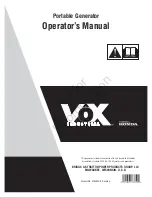
10. Attach handles (
H
) to brackets on generator frame as
shown, with 45 mm capscrews (
J
), flat washers (
K
),
nylon washers (
L
), and M8 lock nuts (
M
).
NOTICE
DO NOT overtighten. Handles must be able to
move up and down freely.
11. Return generator to normal operating position (resting
on wheels).
12. To apply brakes, push down firmly on handle of both
clamps until it locks in the down position and engages
the wheels.
NOTICE
The generator is designed to be used on level
surfaces.
13. Loop handle pins (
N
) on generator frame just above
handle brackets.
14. Raise handles and insert handle pins to move
generator.
15. To release brakes, pull up on handle of both clamps
until it locks in the up position.
Add Engine Oil
• Place generator on a level surface.
• Refer to engine operator’s manual and follow oil
recommendations and instructions.
NOTICE
Check oil often during engine break–in. Refer to
engine operator’s manual for recommendations.
NOTICE
Any attempt to crank or start the engine before it
has been properly filled with the recommended oil will
result in equipment failure.
• Refer to engine manual for oil information.
• Damage to equipment resulting from failure to follow this
instruction will void warranty.
Add Fuel
NOTICE
Refer to engine operator’s manual and follow fuel
recommendations.
1. Clean area around fuel fill cap, remove cap.
2. Slowly add unleaded gasoline (
A
) to fuel tank (
B
). Be
careful not to overfill. Allow about 1.5" (4 cm) of tank
space (
C
) for fuel expansion.
3. Install fuel cap and let any spilled fuel evaporate before
starting engine.
8
www.voxindustrial.com
WARNING
Fuel and its vapors are extremely flammable
and explosive which could cause burns,
fire or explosion resulting in death,
serious injury and/or property damage.
WHEN ADDING FUEL
• Turn generator engine OFF and let it cool at least 2 minutes
before removing fuel cap. Loosen cap slowly to relieve pressure
in tank.
• Fill fuel tank outdoors.
• DO NOT overfill tank. Allow space for fuel expansion.
• If fuel spills, wait until it evaporates before starting engine.
• Keep fuel away from sparks, open flames, pilot lights, heat, and
other ignition sources.
• Check fuel lines, tank, cap and fittings frequently for cracks or
leaks. Replace if necessary.
• DO NOT light a cigarette or smoke.
C
B
A
Not
for
Reproduction









































